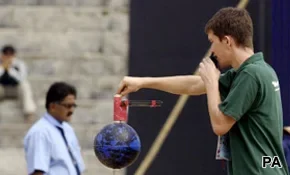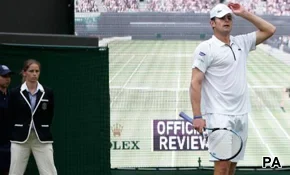Our survey finds that SportsLab respondents who took part tended to support the use of technology in sport
Technology to assist decision-making has been a good thing for cricket, rugby and tennis, according to SportsLab fans of those particular sports. An overwhelming number of SportsLab football fans also believe that video technology should be used in the game in some shape or form.

What's your opinion on technology in sports? What about sports that we haven't covered in this survey? DO you agree or disagree with the comments made here? Have your say below

1. Cricket
There is widespread approval from SportsLab cricket fans on the use of technology in the sport, which has embraced gadgets including the 'Snickometer', which measures noise as the ball passes the bat to help determine whether or not the batsman edged a delivery, 'Hot Spot', an infrared imaging system which shows whether the ball has made contact with bat or pad, and 'Hawkeye', which is used to help judge LBW decisions, tracking the trajectory of the ball to predict whether or not the ball would have hit the wicket. All three systems are endorsed as either 'mostly reliable' or 'completely reliable' by the overwhelming majority of SportsLab cricket fans who took our poll. In addition, instant and slow-motion replays are also used by Third Umpires at the top end of the game to judge difficult decisions including debated boundaries, catches and run outs.

Why has technology been good for cricket?
"It ensures better and consistent decision making than the human eye." – 'Huffy', SportsLab participant

"In helping with LBWs, which has encouraged spinners (like Graeme Swann) to bowl with more variety and has encouraged umpires to be bolder with such decisions. In helping with whether an edge (or not) was found through to the keeper or close field, and with run outs and no balls. It has made for a fairer game in my opinion with more correct decisions being made game after game." – Andrew Carr, SportsLab participant
"It adds to the excitement and shows how good the best umpires are." – Gareth Jones, SportsLab participant
"My father used to be a professional cricket umpire and always believed it would make umpires redundant...he was proved wrong[;] it aids cricket and we now always get the right decision, which can only be a good thing." – Paul Julian, SportsLab participant
Why has technology been bad for cricket?
Not all are enamoured with the emergence of technology, however, with one anonymous participant explaining that, with technology to lean on, "umpires [are] reluctant to make calls they could easily make" themselves. Nonetheless, the most common refrain when asked how cricket should change its use of technology was that it should be rolled out across the world.

Changing how technology is used in cricket
"All test matches should use it all the time - it's crazy that some countries can opt out. The ICCC should subsidise poorer nations' organisations to help them afford the necessary equipment." – Gareth Jones, SportsLab participant
"Make it standard across the test environment. It would be useful for technology to always check on a no-ball situation and automatically inform the umpire, rather than the umpire having to watch the bowler's foot as well as everything else" – anonymous SportsLab participant
2. Rugby
Most rugby fans in the SportsLab poll thought that technology has been good for the sport. In Rugby Union, the referee is able to call on a Television Match Official (TMO), who has access to television replays, to make decision on tries and kicks at goal. Video replays can also be used to assist major decisions in major Rugby League matches.

Why has technology been good for rugby?
"When a judgement given is clearly wrong there is obviously much anger. Rugby cannot afford a nation to lose a world cup based upon a judgement of a man who doesn't always have full view of the situation and is tired having run around the pitch for quite a while." – ‘Hbomb’, SportsLab participant

"In rugby the game is so fast that it is difficult to judge what has happened in real time. Also, because there are so many players around the ball it is not always possible to see whether there has been a try or not and it's useful to check whether the player with the ball has ran or slid out of play" – anonymous SportsLab participant
"It has enhanced the accuracy of the referees' decisions… by a substantial margin, therefore also reducing both the pressure on the referee... It also almost completely removes the possibility of negative actions towards the referee. I would also argue that it ADDS some tension and excitement to the atmosphere of the game. It also gives the viewer (primarily at home) a different view of the game, in a way that involves them a little bit more." – anonymous SportsLab participant
Why has technology been bad for rugby?
"Referees are now reluctant to make calls they would have done in the past and could easily make" – anonymous SportsLab participant

"Too many delays; some decisions are still debatable." – Gareth Jones, SportsLab participant
"They [replays] don't cover all the rugby League games and the game is not played in slow motion" – anonymous SportsLab participant
Is there anything you would change about the way that video technology is used in rugby?
"Allow the referee to check more things - such as whether the correct ball was being used in the Wales Ireland six nations match, where the try should have been disallowed but the referee was not allowed to ask the TMO the question." – anonymous SportsLab participant
"I would allow the video official to intervene when a really blatant professional foul, such as stamping takes place. The viewing public see it, so justice ought to be done in real time, not a fine after the match." – anonymous SportsLab participant
"The crowd should always be able to see what the TMO is seeing. It is frustrating when there is a long delay over a difficult decision and the crowd cannot see anything of what is being used to decide. It would also avoid the situation where the technical crew were showing the wrong bit of play (which has happened) as the ref would be able to see that it was wrong." – anonymous SportsLab participant
3. Tennis
Top-level tennis uses the ‘Hawkeye’ system to determine whether or not the ball bounced within the confines of the court, with players entitled to a limited number of challenges to the umpire’s call per set. Tennis fans in the SportsLab were overwhelmingly positive about the impact of the technology.

Why has technology been good for tennis?
"…there are times when the ball is so close to the line its not always possible for the judges to see. Also the players can no longer blame the umpire for making "mistakes" – 'Tangent', SportsLab participant

"Hawkeye has been great for tennis as it adds fairness and accuracy to the game, and… it relieves some pressure for the umpire and linesmen involved. The way it is used is very good, in the way that the players are limited to a certain number of protests per game, as it allows the speed of the game to continue, without the need for a pause after very controversial shot." – anonymous SportsLab participant
"It adds drama, gives players limited chances to question line calls so the technology is used sparingly and so does not undermine the umpire or line judges, thus keeping the element of human error... be that on the part of the line judge or players." – anonymous SportsLab participant
Why has technology been bad for tennis?
Not a single participant to our poll argued that the use of technology has been bad for the sport.

How should technology be used differently in tennis?
Calls for changing the way technology is used in tennis relate primarily to how often it should be used.
"Make it totally automated to every shot is shown as out or not, so there is only a need for one umpire." – Christopher Duff, SportsLab participant
"Should be introduced in all high profile tournaments outside of the major" – Claire, SportsLab participant
"I wish that it was used for all points for the umpires to call the score without the players themselves having to make a challenge if they think the wrong decision is made. Then there would be no cases of players losing points unfairly, as all the points would be correct in the first place." – anonymous SportsLab participant
"Maybe two rather than three [challenges] per set, as players clearly sometimes use it for a breather but [it] doesn't really slow things up much as [there are] natural breaks in tennis anyway." – anonymous SportsLab participant
4. Football
Technology to help officials is a recurring theme in football, with debate focussing primarily on goal-line technology to determine whether or not the ball crossed the line, but with many advocating its use in other aspects of decision-making in the game. SportsLab football fans are broadly in favour of technology being used in some form or another

Would technology been good for football?
"As a referee it is physically impossible to see everything that happens on a football pitch. Especially if a ball is kicked at 70mph and hits the bar and crosses the line for a goal but then bounces out. Surely the game would be better if the amount of incorrect decisions made by a referee were reduced. It’s not the referee's fault they don't see an elbow on a player or if the ball crossed the line because they are only human. The game of football has rules which need to be applied correctly and technology will be able to help the referees do this." – Christopher Duff, SportsLab participant

"[Technology should be used] because of the financial implications of erroneous decisions by officials." John Lennard – SportsLab participant
"So many games have been swung on a decision not to award a goal when the ball has clearly crossed the line, such as the 'goal' scored by Frank Lampard at the last world cup. Conversely it could be used to disallow a goal which has clearly not crossed the line, like England’s third goal in the 1966 world cup final." – anonymous SportsLab participant
"It is not visually possible for linesmen to see accurately the whole width of the pitch to determine if the whole of the ball is across the line. Often none of the officials are in the best place to observe and it [technology] would help reduce the inconsistency in the officials" Fox Talbot – SportsLab participant
"It will ensure that decisions (especially contentious ones) are correct on the overwhelming majority of occasions. Look at Rugby and Tennis, where there is no predictive element required. It has completely eliminated disagreements, arguments and dissent - and has added to, not detracted from, the spectator experience. It MUST be better for the game that the correct decision is arrived at." – Chris Hackett, SportsLab participant
"There are too many controversial decisions made that affect high risk games which could resolve the same. And it stopped fans of teams which aren't my own from chanting that they were 'robbed' instead of graciously accepting the result!" – Nina, SportsLab participant
Would technology been bad for football?
"Because if every decision was spot on there would be no talking points and the game would become very predictable. And even if there is technology, it is still down to the opinion of that one person viewing the image and making the decision. Who’s to say they will get it right? It also takes decisions away from the ref who may have seen it differently and not agree with the decision." – C.Billingsley, SportsLab participant

"Controversy after the match can continue discussions, forums about the game, was it a penalty; did the ball cross the goal line; was it a foul? If you had GLT all this would be gone – and what would we talk about on Saturday night and Sunday?" – David McQueen, SportsLab participant
Nearly all SportsLab football fans who contributed agree that goal-line technology should be introduced. A majority also support it to assist in making decisions on penalties, red cards and off-sides. However, fans are against bringing in technology for all decisions: using it to decide whether or not a foul had been committed in open play garnered support from less than a fifth of SportsLab football fans who took part.
Conclusions
SportsLab fans from across a range of sports where technology is already in use agree that it has a positive impact, and football fans strongly support its introduction. However, there is a concern, which runs across tennis, cricket and rugby, that it should be used more consistently. In addition to football, boxing, hockey and snooker are among the sports which our participants suggest would benefit from using technology to assist officials.

What's your opinion on technology in sports? What about sports that we haven't covered in this survey? DO you agree or disagree with the comments made here? Have your say below








